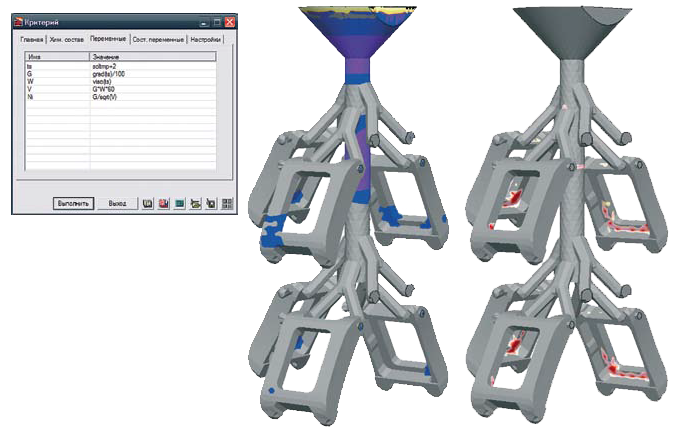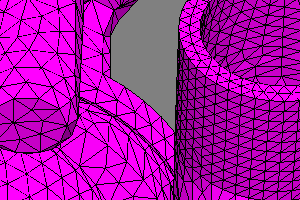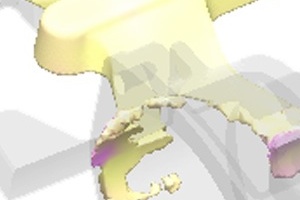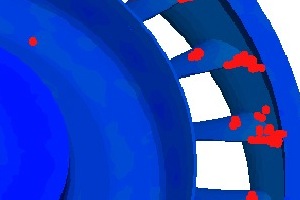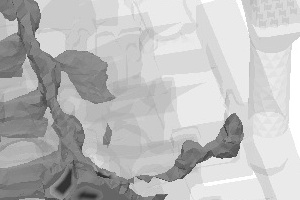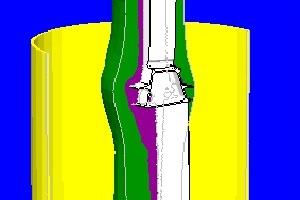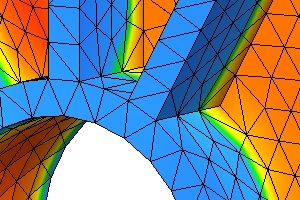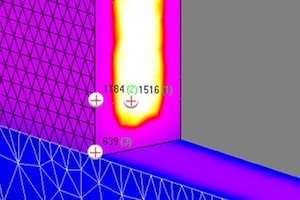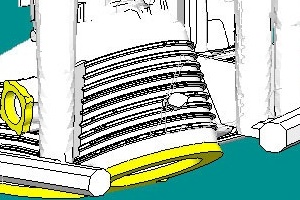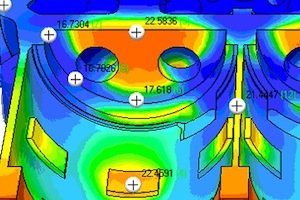CSS PoligonSoft
Casting Simulation Software Suite PoligonSoft (CSS) “PoligonSoft” is the professional tool for the creation and optimization of the foundry technology. “PoligonSoft” works on the basis of finite elements method and performs the analysis of fillining, crystallization and stresses for the most part of the casting technologies and any alloys.
DOWNLOAD THE BROCHUREWork with the geometry of any complexity
Thanks to the finite element approach CSS “PoligonSoft” works correctly with the geometrical model of casting block of any complexity consisting of a multitude of bodies of arbitrary shape. The cooling plates, sand cores, support fillers, mold boxes, heat insulating materials and elements of melting equipment affect the quality of the foundry to some extent and this influence can be taken into account in the calculation.
The module “Master-3D” allows to download and to use the meshes of the following formats: Altair HyperMesh, ANSYS, ProCAST, Nastran, CATIA V5, NEU, GiD, ISPA. The user only needs to download the file with mesh model of casting block and “Master-3D” will independently determine what bodies are the foundry and what are the elements of the mold and will assign the boarders of the bodies interface.

In some cases, the simulation model of the casting block may include up to hundreds elements. To enable the engineer to work with big models easily the “Model tree” has been added to the “Master-3D” that allows to control the visualization and configuration of the objects flexibly.
The own generator of the thin shells allows to generate the multilayer shells of the given thickness in the CAD system without preliminary constructions. Such relatively simple elements of computational region as the covers, lining, heat insulation, etc can be created in this way.
«PoligonSoft» has its own verification devices of the finite-element mesh quality (the corners and volumes of the elements are checked). Unsatisfactory elements can be corrected or deleted from the simulation model. A special algorithm analyzes the geometry for the presence of thin walls and locally divides the mesh to improve the accuracy of the calculation.
Filling of the mold
“Euler-3D” module allows to calculate the filling of the mold with the melt with constant or variable speed through one or several sprues. With its help you to analyze:
- temperature of the melt and the mold during the filling process;
- feed ratees;
- misruns.
A special parameter regulates the number of solid phases at which the melt flow stops. The application of this parameter allows to adjust the operation of the module in such a way as to simulate the stop of the supercooled melt flow. The flowability reference data can be used as a master sample.
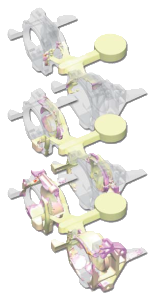
Cooling of the foundry and the mold
“Fourier-3D” module performs the calculation of the temperature and phase fields taking into account the heat generation during crystallization, solves the filtration task including the simulation of the pressure fields. The module allows to calculate:
- the process of foundry crystallization (temperature and fraction of a liquid phase);
- overheating and supercooling of the mold;
- hot zones in the foundry and in the mold;
- Shrinkage cavity, macro and microporosity.
“Fourier-3D” allows to perform the complex multistage calculations during the process of which the cooling conditions and the geometry of computational field can be changed. The quality and authenticity of the calculation directly coincides with the possibility of end-to-end simulation of the technology. All stages of the technological process of the foundry production can be consecutively simulated in the “PoligonSoft” system: heating of the mold, cooling of the mold prior to casting, filling of the mold, heat insulation of the block after casting, holding after casting, cooling in the thermostat or on the workshop floor, insulation materials taking out, shaking out, etc.
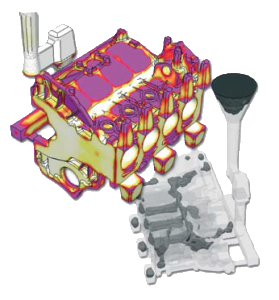
Cyclic processes
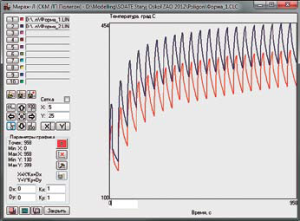
Control of temperature changes in the mold by the cycles during press molding in “Mirage-L” module
Radiation transfer

Porosity
One of the apparent advantages of CSS “PolygonSoft” is a shrinkage macro- and microporosity model, which allows to predict the formation of defects in critical duty castings (working and nozzle blades of GTE, monocycle, impeller pumps, etc.). For a long time, this model was not only the most advanced and accurate, but also the only one in the world. And now “PolygonSoft” successfully competes with the best world Casting Simulation Software, holding them out in functionality, but not in the accuracy of the prediction of shrinkage defects.
Starting with version 13.4, a new model of shrinkage and macroporosity formation has been introduced into the “Fourier-3D” module based on the improved method of stepwise determination of the shape of the shrink head, taking into account the capillary effect and the pressure drop during the crystallization of hot zones.
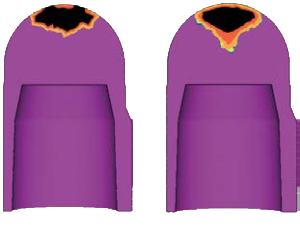
Warpage and craсkes
“Hooke-3D” module is designed to calculate the temperature stresses and strains that occur in the foundry and the mold during cooling stage. The calculation is performed on the basis of the theory of small elastoplastic strains created by A. Ilyushin and Newton method. The module allows to calculate:
- * temperature stresses;
- strains;
- Casting warpage;
- the locations of possible creation of cold and hot cracks.
The reliability and stability of the algorythms of “Hooke-3D” module allows to use it for simulation of heat treatment processes (water hardening, for example) with the purpose to determine the residual stresses, strains, warpage and possible destruction. The modern version of “Hooke-3D” module allows to perform stress calculation both in the casting and in the mold having up to three randomly oriented principal planes. The module supports the hand and automatic modes of fixation of the casting in space. The mechanisms of recording the calculation state allow to continue the calculation interrupted for technical reasons or to restart it with the changed parameters and/or from the moment of time freely saved.
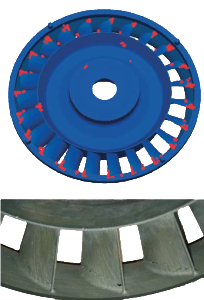
Simulated foundry technologies
CSS “PoligonSoft” allows to use any alloys and nonmetal materials (heat insulation, lining, cores, molds, etc) in the calculations, to simulate all most popular foundry technologies and some special processes:
- sand casting with any compound;
- chilling (including cooling);
- investment casting;
- vacuum casting (including directional solidification);
- high pressure molding;
- low pressure casting;
- continuous casting;
- liquid forging;
- solidification taking into account the electric current supply;
- cyclic processes.
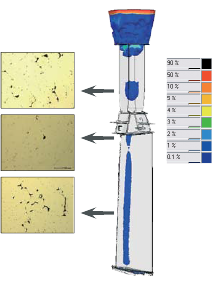
Data base of CSS “PoligonSsoft”
To simulate the foundry technology, it is necessary to use the heat, shrinkage, mechanical and other properties of the materials of the foundry, mold and mediums. CSS “PoligonSoft” has the flexible and multifunctional module “Alloy” that combines the reference book, means of storage, editing and synthesis of materials properties, boundary and initial conditions.
«PoligonSoft» is supplied with the basic data base in which the properties of some steel, cast iron, aluminum, nickel, titanium, copper, zinc and precious metal alloys are included. In addition, along with the system the mold materials data base is supplied which includes the properties of sandy-clay and liquid-glass mixtures, ceramics, chamotte, asbestos, heat-insulating and many other materials used in foundry. This data base can be edited and added by the users.

The function “Synthesis”
The built-in synthesis mechanism makes it possible to predict the properties of a number of foundry alloys by their chemical composition:
- gray iron (by analytical dependencies);
- steels (static treatment);
- aluminum allows (static treatment).
Properties calculated with the help of static approach depend on alloys data base that also can be added by the user with the purpose to increase the prediction accuracy.
Boundary and initial conditions
The system of initial and boundary conditions on the basis of the indexation of volumes and boundaries used in CSS “PolygonSoft” allows adjusting the work of the program so as to minimize the time for preparation for calculation and to reduce the requirements for the qualification of personnel while maintaining the quality of the engineering analysis of the foundry technology. Once the user creates the files of boundary and initial conditions, that answer the requirements of foundry technology of the enterprise, and then only uses the readymade samples in everyday work. Such approach allows to perform the calculations with different models quickly but in the equal conditions.
Reference data
The reference data is one of the most important element of the module “Alloy” and contains the information about the properties almost all properties and parameters of the mterials required for calculations performing. This information was taken from the reference literature, publications in periodicals, some data were received experimentally by the developers of CSS “PoligonSoft”.
CSS «PoligonSoft” for bulky foundry
In combination with the ability to use symmetry and multithreaded computation, the modeling process takes quite an acceptable time. At the same time, the computing resources used (primarily the amount of RAM) do not go beyond the boundaries of ordinary office PCs.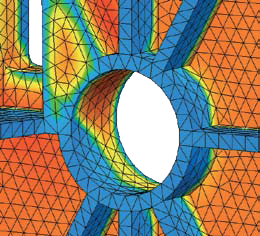
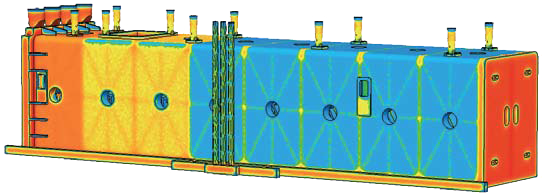
Simulation of continuous casting
Starting with the version 13.1, CSS “PoligonSoft” can use the finite element models with unmatching meshes for modeling. This not only simplifies the preparation process of the model to the computation but also allows to specify the “sliding” contacts such as “foundry – mold”, “mold-mold” and “foundry-foundry” at mutual movement of geometrical objects. New possibilities allow considering the tasks of continuous casting – in particular, to simulate the initial process stage: billet withdrawal.
Temperature in the system to the moment of prestart holding ending Details of heat picture in the crystallizer zone Details of heat picture in the molded part of the casting block 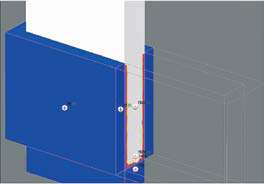
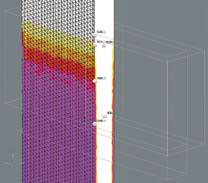
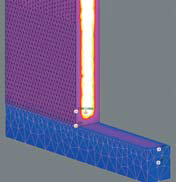
CSS «PoligonSoft” for ingot casting
The method of finite elements allows to place the grid points directly on the boundary lines of the bodies that in combination with the application of matching meshes of the foundry and mold minimizes the error and allows to calculate the cooling process of the ingot with high accuracy. 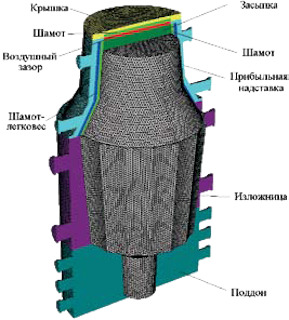
CJSC «CSoft» took part in the sceince and research work organized by the company Siemens together with OJSC SPU “CNIITMASH”. In the course of this work, the technology of production of two ingots was simulated and compared to the experimental data. A comparison of the cooling curves obtained in the CSS PolyongSoft with the measurements made with the help of thermocouples installed at a depth of several millimeters below the surface of various parts of the mold showed good agreement of the calculation results with the experimental data.
The chill mold should withstand as much number of fillings as possible but the prolonged thermal stresses can cause it to crack. That’s why the research of its resistance seems to be quite actual task. The analysis in the module “Hooke-3D” of the stress-strain state of the mold by the criterion of crack susceptibility allows to reveal the location of dangerous zones and, if possible, to take measures to reduce the temperature stresses in its body.
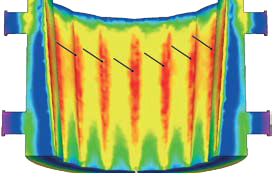
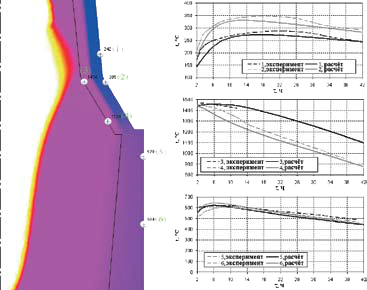
Simulation of internal chill
The internal chills are produced from the same alloy as the foundry and installed inside the mold cavity forming the foundry body. During the filling of the mold with the alloy the internal chills partially or completely melt and welds with the basic metal. The technologists are interested how the simulated chill can influence the heat picture of the foundry, its crystallization and how much it prevents from shrinkage porosity appearance. The possibility to simulate this process is the peculiarity differing CSS “PoligonSoft” from many similar systems. The chillers are set as separate elements of computation system having the given temperature at the beginning of the computation. Then during the crystallization process, they are considered by the solver «Furje-3D” as a part of the foundry. It gives the possibility to calculate the melting of the chillers taking into account the thermal absorption during phase transfer and therefore correctly predicts the occurrence of the porosity and temperature changes at the places of its location. Places of installation of internal chillers 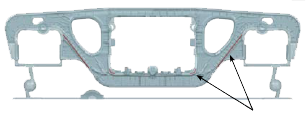
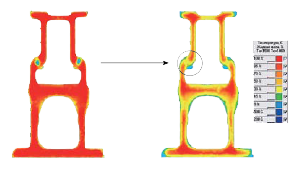
Additional possiblities
Расчет прочности (ОАО «Звезда») 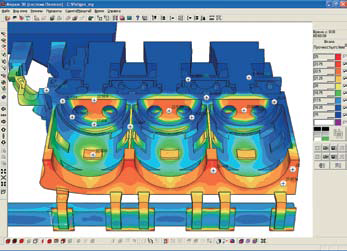
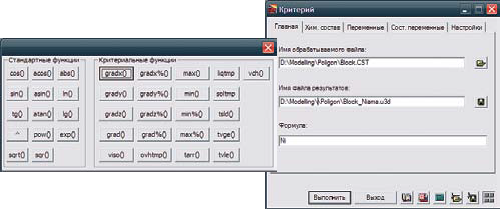
Additional possiblities: Niyama criterion
Although CSS “PoligonSoft” predicts the shrinkage porosity using its own specialized model the user can apply “Criteria-3D” for computation of Niyama criterion. This dimensionless criterion takes into account the local thermal conditions, for a long time it was standard for all simulation software packages. Many foundry productions worldwide still use it for prediction of porosity in the foundries. Founders using the simulation analyzes the value maps of Niyama criterion and assume that the shrinkage porosity will be formed in the areas where Niyama criterion is below some critical value.
